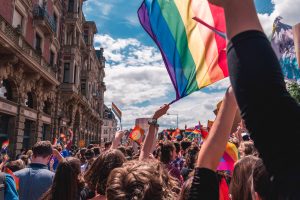May 17 is the International Day against the prejudices of homophobia, biphobia and transphobia.
The word phobia simply means fear. It is the uncontrollable, irrational, and lasting fear of a certain object, situation, persons or activity. This fear can be so overwhelming that a person may go to great lengths to avoid and/or attack the source of the fear. People who are homophobic, biphobic or transphobic respond in fear by words and actions toward members of the population who identify as homosexual, bisexual or transexual.
Actions caused by uninformed fear can have serious consequences. Here are a few facts to illustrate how this fear can impact the LGBTQIA+ community, with as many as 11 in 100 Australians identify as having diverse sexual orientation, sex or gender identity:
- Over a third of LGBTQIA+ people feel they need to hide their sexuality or gender identity when accessing services, attending social events or applying for jobs.
- Six out of ten people identifying as LGBTQIA+ report experiencing verbal homophobic abuse and 2 out of 10 report experiencing physical abuse.
- Transgender men and women experience significantly higher rates of non-physical and physical abuse, particularly trans-men.
As a result, LGBTQIA+ people are three times more likely to experience depression compared to the rest of the population.
We know there are entire populations in our society that are homophobic, but that doesn’t make homophobia, rooted in fear and angry reactivity, an acceptable viewpoint. Being homophobic is similar to the concept of being racist.
Homophobic actions can start in primary school and can develop into:
- Bullying and harassment of children and adults
- Microaggressions eg. deliberately not using a transgender person’s preferred pronouns
- The belief that LGBTQIA+ people don’t deserve equal rights.
- Not socializing with people you suspect to be LGBTQIA+
- Making generalised statements about LGBTQIA+ people
- Thinking that LGBTQIA+ people have “an agenda”
- Thinking that LGBTQIA+ people want to “convert” children.
- Rationalising your dislike for LGBTQIA+ people as acceptable due to your religion or culture
- Acts of violence, up to and including murdering LGBTQIA+ because of their identity
- Believing that LGBTQIA+ people are different from you or are less valuable to the world than you.
- Worrying that an LGBTQIA+ person will try to “convert” one to their orientation
You may be led to believe transphobia is just a part of homophobia. However, that isn’t the case. Transphobia is a very specific dislike of and discrimination against people who are transexual. Transphobia manifests in violence and the denial of gender affirming health care. It’s possible to be homophobic and transphobic at the same time. Transphobia has its own term because it is so prevalent in our culture and has led to countless acts of violence against trans people and legislation against their health care.
Biphobia is an aversion toward bisexuality or people who are identified or perceived as being bisexual. Similarly, to homophobia, it refers to hatred and prejudice specifically against those identified or perceived as being in the bisexual community. Maybe surprisingly, people can also experience biphobia from within LGBTQIA+ communities. Some people may believe that people can only have romantic or sexual relationships with one gender. They may also believe that it is not possible for a person to be attracted to two or more genders.
The impact of homophobia, transphobia and biphobia on people’s lives cannot be underestimated. It can lead to
- Reduced mental health.
- Worsened physical health.
- Stress and trauma
- Increased risk of suicide
- Internalised shame
- Increased risk of substance abuse
- Lower quality of life
Five simple ways you can work against homophobia, biphobia and transphobia.
1. Don’t Make Assumptions
If you find yourself making assumptions about a person you believe to be LGBTQIA+, stop yourself in your tracks. Remember that you don’t know them, and they don’t deserve to have your assumptions put on them.
2. Educate Yourself
Read books, watch TV shows or movies, and follow the social media accounts of LGBTQIA+ people and attend workshops about homophobia to understand the harm caused.
3. Don’t Make Jokes.
Never make jokes about LGBTQIA+ people, as they are genuinely harmful to many. Call it out if you hear such “jokes” made in public.
4. If You Have Questions, Ask
Ask respectfully and politely and accept that you may not receive an answer you expect, like or want.
5. Commit to Being an Ally
Commit to becoming an ally to LGBTQIA+ people. You’ll gain nothing by trying to keep people from having the same rights as you, whereas by advocating for them, you can help the lives of many.
For further information please find below a few websites you might find helpful.
https://www.vicinclusivepractitioners.com/
https://humanrights.gov.au/sites/default/files/FTFLGBTI.pdf
https://www.verywellmind.com/what-is-homophobia-5077409

